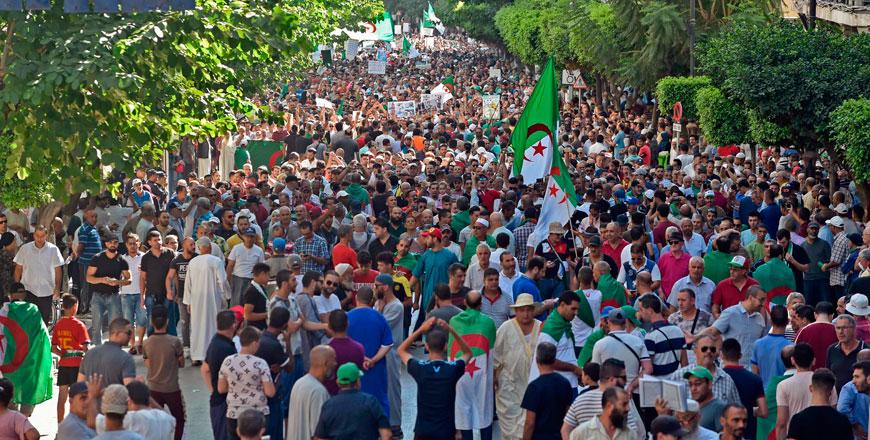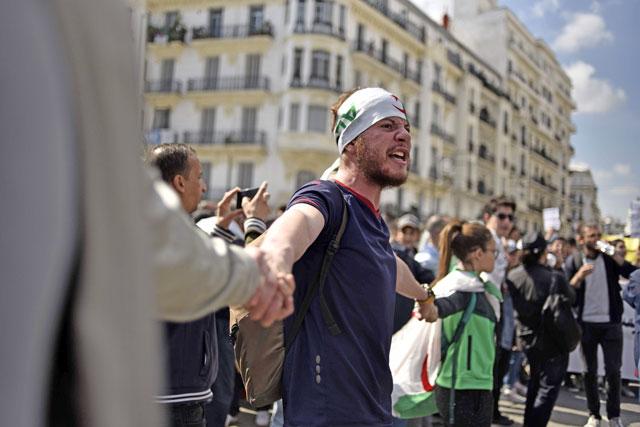You are here
One year of protest in the Middle East
By AFP - Oct 06,2019 - Last updated at Oct 06,2019

Algerian protesters take part in a demonstration against the ruling class in the capital Algiers on Friday, for the 33rd consecutive Friday since the movement began (AFP photo)
PARIS — Mass protests have rocked several Arab countries this year in an echo of the 2011 revolts that toppled long-time rulers in countries including Egypt, Libya and Tunisia.
Here is a round-up:
Sudan: Bashir ousted
Protests erupt in December 2018 against the government's tripling of bread prices after months of biting economic crisis.
Demonstrations continue into 2019, gaining momentum.
Thousands gather outside the army headquarters in Khartoum on April 6, demanding the resignation of President Omar Al Bashir.
On April 11, the army ends Bashir's 30 years in power and installs a transitional military council.
Demonstrators accuse the military of staging a coup and demand a civilian government.
On June 3, armed men disperse the sit-in at the army headquarters. The crackdown leaves scores dead.
After weeks of negotiations, the protest leaders and military sign on August 17 an accord establishing a governing council dominated by civilians but headed by the military.
The council is tasked with overseeing a transition to civilian rule with democratic elections in 2022.
Clashes during the months-long protest movement claimed the lives of more than 250 people, according to doctors.
Algeria: Bouteflika quits
On February 22, thousands demonstrate in Algiers and other cities against President Abdelaziz Bouteflika's plans to run for a fifth term.
The ailing 82-year-old had been in power for 20 years and was severely weakened by a stroke in 2013.
On April 2, after the army withdraws its support, Bouteflika cedes to the pressure and resigns.
But protesters demand an overhaul of the entire political establishment, including the resignation of key figures, such as the powerful army chief, Ahmed Gaid Salah.
For months, large groups continue to gather every Friday to demand changes.
Although the opposition rejects elections under the current establishment, the interim president has called a vote for December 12.
Egypt: Sisi rejected
On September 20, small protests break out in Cairo and other cities, calling for the removal of President Abdel Fattah Al Sisi, the former army chief who took power in 2014.
The rare demonstrations are quashed quickly, protests having been effectively banned by Sisi's hardline regime.
But overnight, demonstrators gather again at Cairo's symbolic Tahrir Square, the epicentre of the 2011 popular revolt that toppled long-time President Hosni Mubarak.
Security forces round up dozens of people and impose tight control over the square.
Large demonstrations also spring up in several other cities, including Alexandria and Suez.
They follow calls to protest issued in videos posted online by a disgruntled Egyptian businessman exiled in Spain.
Rights groups say more than 2,000 people, including lawyers, activists, professors and journalists, are detained in the ensuing crackdown.
Iraq: Violence erupts
On October 1, mass demonstrations erupt in Baghdad and cities in the south of Iraq against unemployment and poor public services, with protestors demanding the departure of "corrupt" government officials.
The demonstrations explode into violence, with thousands of protesters defying security forces who open fire with live bullets.
In four days, dozens of people are killed and hundreds wounded.
By Antoinette Chalaby-Moualla
Related Articles
PARIS — Algeria has been in political turmoil for seven months, with major anti-regime protests continuing even after the resignation o
ALGIERS — Several thousand people gathered in the Algerian capital Saturday on the first anniversary of a protest movement that seeks an ove
ALGIERS — Hundreds of students hit the streets of the Algerian capital Tuesday dismissing President Abdelaziz Bouteflika's promise to resign


















